The Journey
Our preparation begins the night before as I help my dad pack up the 4 X 4 Toyota Land Cruiser the night before we leave to go into the bush. We leave early in the morning leaving behind any semblance of civilization as the concrete jungle straggles out in an ever thinner chain letting the waist-high grass take over. Every so often a village appears ahead of us, a mere blip against the empty horizon. Our destination is the Rendille tribe who live in a mountain-encapsulated desert in northeast Kenya.
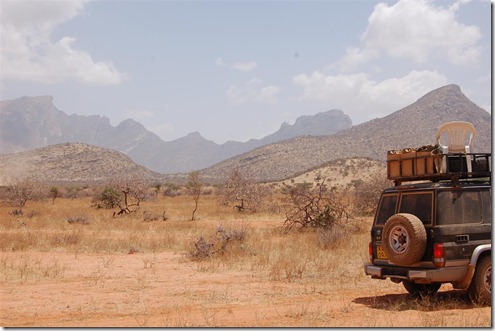
Mountain-encapsulated desert in northeast Kenya – Mt. Kenya (over 17,000 ft)
At first the trip is like any other, a hardtop road extending toward the horizon. After climbing up towards Mt. Kenya (over 17,000 ft), we plunge down into the Rift Valley.
Here the hardtop ends and we leave the road, choosing dirt over corrugated road. We plow through dust sometimes a foot thick. Then we hit the rocks. After a 10 hour trip, we arrive at a collection of huts in Korr that will be our home for the next couple of days.
A Typical Day On The Trip
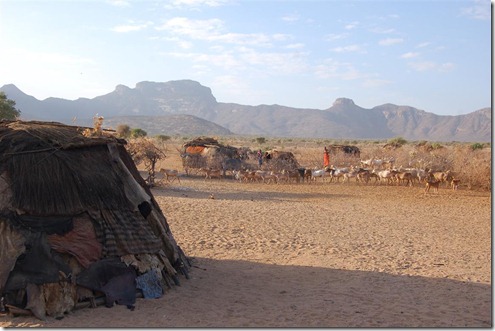
The voices of the herders rise above the movement of the animals coaxing them along the right path. (This is the village of Lekachula. The animals sleep in thorn bush enclosures within the village at night and make their exit as the day dawns.)
Dawn is our wake-up call. We hear the bells of the sheep, goats, cows, and camels tinkle softly as the animals flow in a never-ending stream towards pasture. The voices of the herders rise above the movement of the animals coaxing them along the right path.
(This is the village of Lekachula. The animals sleep in thorn bush enclosures within the village at night and make their exit as the day dawns.)
We turn sleepily to see the grey horizon turning to pink and then orange before the sun explodes into the horizon a glowing ball of fire against the blue sky. I am tempted to sleep-in, but my desire is overridden by the knowledge that people have already begun to congregate around our sleeping quarters anxious to have the first word with us.
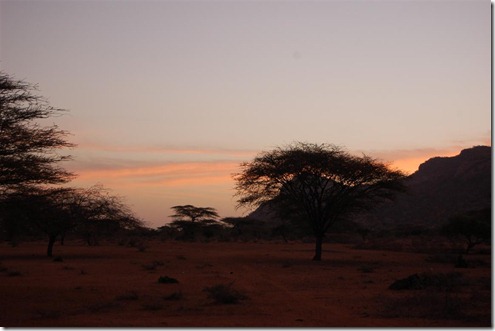
The grey horizon turning to pink and then orange before the sun explodes into the horizon a glowing ball of fire against the blue sky.
Instead, I peer through the white cotton netting above me, finally lifting it up to take a picture knowing that my memory will fade and I will lose the clarity and connection I felt to God being out in his creation with His colors. We complete a morning routine prior to facing the inevitable crowd. This includes a quick wash and shave if water is available (not every location we visit has a permanent water source), a couple of cups of hot tea (made with drinking water we’ve brought along with us) with a couple of handfuls of dry cereal, and a
devotional time in the Word. On this particular trip, we went through First and Second Peter.
Reinforced physically and spiritually, we venture out to the gathered throng. Most of the people are here because they know that we have medicine (simple antibiotic and cures for common illnesses such as malaria) and want “the medicine that you gave me last time” for ailments varying from headache to scabies. I was saddened to see children with eyes swollen shut from eye infections or shaved heads, white as if they had come from a bakery, with scabies rashes. A little cheap ointment will take care of their problems and greatly improve the quality of their lives. Other sicknesses like malaria, dysentery, or typhoid are harder to cure and much more deadly. We help as God gives us guidance. I thank God that He is the Healer not only for their physical ailments, but also for their sins.
Once the crowd has thinned, satisfied with our help, we pile into the car for our next trip.
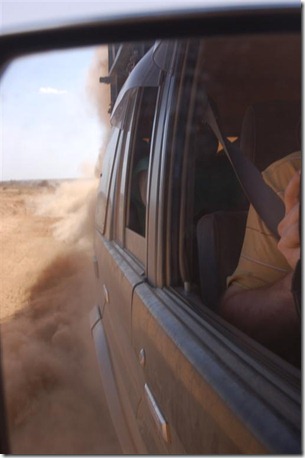
Riding on the dirt tracks.
As we have several base camps, we do not have to pack up camp everyday. It takes anywhere from 30 minutes to 1 hour along dirt tracks to reach our destination. How happy our local evangelists are not to have the walk to three or four hours it would take them usually! Along the way, we typically pick up someone walking towards our destination. This gives our evangelists a chance to witness to them right there in the car and possibly lead them to Christ or receive an invitation to their village. At any rate, we reach the village that we intend to go to and before we’ve even parked the car, a crowd of curious children materializes as it were out of thin air and surrounds the vehicle saying, “Underhill, Underhill.” They recognize the car even before they can see us in it. After shaking numerous hands, we venture away from the car and into the village often leaving a sentry, so that the car is not damaged by their curious hands. They love looking into the sheen of the metal to see their reflections as they don’t have mirrors and may never have seen themselves before! Our entourage follows us into the village and we approach our contact’s hut. They are often outside the hut to welcome us in.

A Rendille hut.
A Rendille hut is about 5 foot high at its apex. Its door faces the west and is about 3 foot high and 18 inches wide, so I have to bend over double and twist as I enter. The Rendille do this to make it difficult for a marauding band to enter their huts and give them a good chance for self-defense. The hut has no windows and is a framework of sticks (There is a bush with branches that bend without breaking to form the curved dome of the hut.) covered with flour sacks and cardboard. As it rains so infrequently, having a watertight structure is of little importance. (When the rains come they bring out a plastic tarpaulin to cover the hut.) The floors are of mud. The more affluent have sheep or goatskins to sit and sleep on. Others use cardboard.
Typically, the “kitchen” is in the hut and consists of a couple of stones. Wood is the typical fuel. I try not cough as the kitchen fire roars to life to heat water to make us a cup of tea. Most do not have milk or sugar for the tea, so we bring along these items and make a quiet donation through our evangelists so that they don’t lose face. They are extremely embarrassed if they can not provide this hospitality. In each village, we make several of these visits depending on how many people we know in the village. The huts are small and group visits are not possible in this venue.
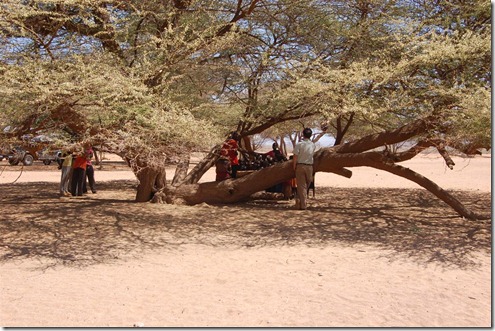
Sometimes our kindergarten schools meet under a tree in a dry river bed as this is the coolest and most comfortable spot to sit.
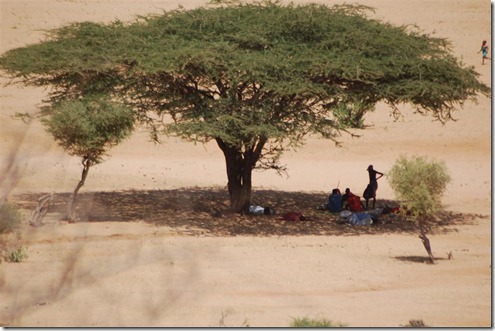
Not far away from them are the wazee, the group of the village elders, also under a tree, spending the heat of the day in the coolest spot they can find.
At some villages, we have kindergarten and even elementary schools. So, a visit to the village is not complete without a visit as we are the sponsors. My primary purpose for this trip is to see the schools, so I will discuss them at length in a separate paragraph. At the schools, everything stops and all attention is directed to us. Each guest is expected to speak and each of us has a chance to express the Gospel. The children respond by singing “church” songs that they have learned. I am touched when I realize the difference that I can make in so many childrens’ lives.
Sometimes our kindergarten schools meet under a tree in a dry river bed as this is the coolest and most comfortable spot to sit. Not far away from them are the wazee, the group of the village elders, also under a tree, spending the heat of the day in the coolest spot they can find. We take the opportunity to walk over to this group of men and tell them about Jesus. They are the ones that “control” the spiritual direction of their village. They are deeply entrenched in the mila (the traditions of their ancestors.) However, they are receptive to any message about God.
One particular group responded to our challenge to follow the God of the Bible and His Son Jesus by saying that they were too old to change, but “you can hear our children singing the songs of Jesus in our village.”
This underscores the power of our provision of education to open the village for a total change of direction. Another group asked us to start a church and kindergarten in their village as we have done for others.
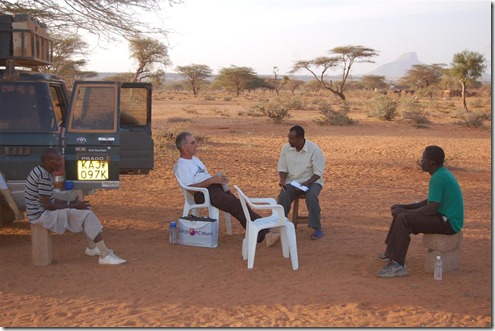
Back to base camp.
By now we are all thinking about going back to base camp. Our water canteens are empty, the sun is still beating down like a hammer on our steely heads. Our stomachs resonate like a snare drum. So, we head back to base and cook our daily meal. We bring whatever canned or dried food we can as there is no electricity for refrigeration and no fresh fruits or vegetables to speak of in the whole region. My dad insists on cooking as he says he has the routine down. He gets out our small propane burner and sets a metal pot on top of it. Then he measures out the precious water we have brought and ladles it into the pot. In goes some rice, corned beef or salmon, and peas or dried spinach. A tomato soup mix gives added flavor.
Two times during our trip a sheep was prepared in my honor. This provided a “fresh” alternative to our usual meal, but is not a sustainable diet for those who are not used to it. When was the last time that you ate a quarter of a sheep!?! Maybe it’s just desert sheep, but there is not as much meat on them as you would think. However, it is deliciously roasted over an open fire. I’m glad I can sit under a tree and not do the roasting! The fire seems almost unnecessary!
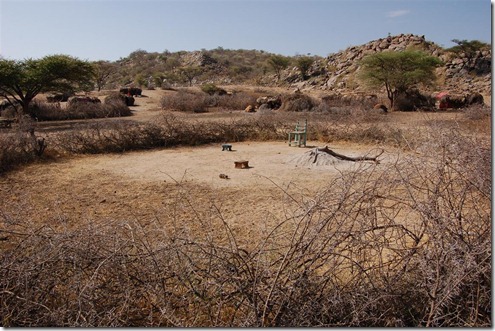
The naboo. This is the sacred enclosure in the center of each village in which the villagers believe God dwells. Only married men, wazee, are allowed in here. Every evening prayers for health and protection are offered to their god, the moon. They keep a log “burning” or glowing 24 hours-a-day.
In either case, our meal is washed down with the usual cup or two of hot, sweet tea. This gave us energy for our evening “program.” In the evening we go back into the village around which we are based to visit the naboo. This is the sacred enclosure in the center of each village in which the villagers believe God dwells. Only married men, wazee, are allowed in here. Every evening prayers for health and protection are offered to their god, the moon. They keep a log “burning” or glowing 24 hours-a-day. They are very open to any word from God, so we have an excellent opportunity to tell them of the true and living God who made the moon and all creation.
The typical response to our message is “Thank you for that great message from God. We have been blessed by your message. However, we need time to think about it, and we need to hear it again and again.”
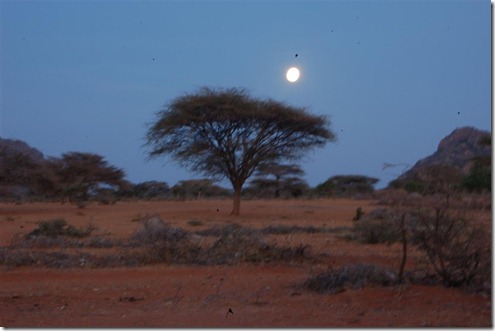
Trudging back from the village via the light of the moon.
We trudge back from the village via the light of the moon stepping over the low-lying thorn bushes and animal scat (my son, Noah, tells me that this is the correct word to use). We never saw any wild animals, but we are told that there are snakes, hyenas, and other animals in the area. Once a two-foot baby poisonous snake materialized out of a tree during one of our meetings. Within several seconds a man was beating at it with his stick and it was dead.
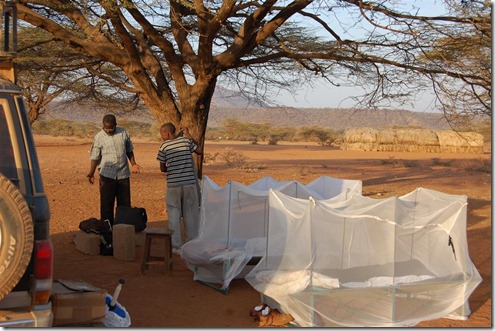
Our bedroom under a tree.
Our bedroom is either in a hut or under a tree. I honestly felt more comfortable being under the tree as the night-time breeze is actually cool! You’d think that sleeping would be easy given the country living, but it was not! The night air is punctuated by all kinds of sounds.
Typically I heard the braying of donkeys, the bleating of sheep, and the mooing of cows. I’m not sure what sound camels make or if I heard them. Once I got used to those sounds, I would hear sounds of people talking the night away or children playing together in the village. The warani (warriors) were nearby singing through the night to entertain themselves as they watched their herds of cattle. The warani are a group of young men that spend 14 years of their lives looking after the village’s cattle as the herds have to travel away from home to find pasture. It is an extremely lonely and dangerous life. Often they have to protect the herds from enemy raiders who want to steal the cattle. It is imperative that we reach the Rendille youth prior to their going on this adventure as they will be away from their village for 14 years. They love bright colored clothes and red paint on their faces.
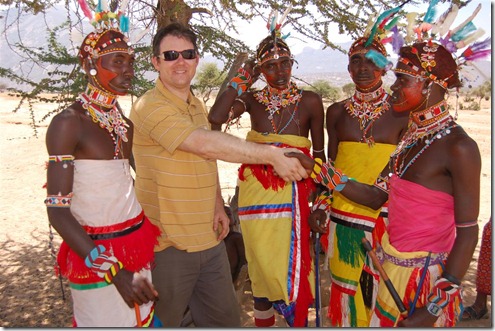
The warani are a group of young men that spend 14 years of their lives looking after the village’s cattle as the herds have to travel away from home to find pasture.
The Education Programs
The vast majority of the people that live in the Rendille villages (goobs) are illiterate. They have never spent a single day in a classroom as they have never had any to go to. Over the past few years, Trinity Baptist Church in Nairobi has sponsored several kindergarten and elementary schools. The community is supposed to build the buildings and then the government provides the teachers and textbooks. Unfortunately, this model has not worked in this region as it has in other parts of the country. Perhaps it is due to the lifestyle lived by the Rendille that does not require education. Why the push for education one might ask? I believe that in order for the church to grow in Rendille education is necessary. Without being able to read for themselves, Rendille believers will be reliant on others for their Biblical knowledge. When we are urged in the New Testament to “search the scriptures,” the implication is that we will be able to read them for ourselves. So, how
has Trinity Baptist Church sponsored schools and how can more schools be sponsored in the future? Kindergarten is the easiest level of education to provide and the most necessary due to the total lack of education in the region. The typical kindergarten consists of a high school graduate (the teacher), a cook (for the school lunch), and the students.
Materials are a portable black board and a few pieces of chalk. The site is the nearest shade tree to the village. Elementary schools typically start off as a shade with a metal roof and may graduate to a stone building as funding is procured. Other variations include a thatch building or mud building. Trinity Baptist Church has supplied materials to build temporary shelters and pay teachers while waiting for the government, government-sponsored groups, or organizations such as World Vision to lend support in building more permanent facilities. If we are to keep pace and lead the people in the Adventure of Becoming Like Christ (mission statement borrowed from Church of the Open Door, Elyria, OH), education is a necessary part of the adventure.
What does it cost to “run” a school under a tree, metal-roofed shade, or stone building? It costs between $50-$100 a month per class depending on the quality of the teacher and amount of materials and food needed. Can you imagine being a first responder and providing education to a whole village of children for under a $100 a month? The elders of the village have told us that “the name of Jesus is sung in our villages.” How wonderful is the name of the Lord!
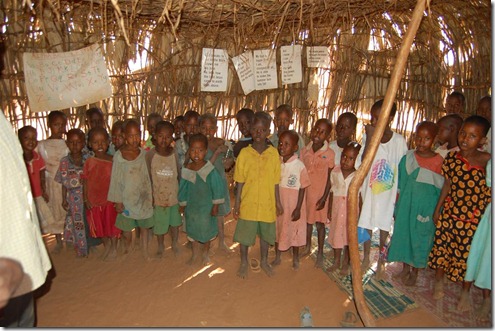
It costs between $50-$100 a month per class depending on the quality of the teacher and amount of materials and food needed.
What has God revealed to me as my role in this adventure? Trinity Baptist Church is looking for someone to assist in the educational aspect of the ministry in Rendille. I believe that this is something I can do from location in the US. I believe that several visits a year to provide encouragement and training to local Christian leaders on the ground and establish working relationships between the PTA, local Kenyan government agencies, World Vision and other such agencies, and church supporters will provide an environment in which these schools can flourish. During my visit, I established contacts within the first three groups.
Now I appeal to you brothers and sisters in the Christian church. I believe that I am well suited for a role as an advocate for the Rendille people and potential supporters of the Lord’s work there. This is not a new desire for me. It something that the Lord has been whispering to me ever since I was a junior in high school. But now He is providing me with means that I can not ignore. He has shown me in numerous ways that He will provide for His work and I am confident in that fact. I believe that He has already chosen from among the readers of this report those who will help the work in Rendille and other unevangelized areas of the world, so that by aiding directly in church planting work and indirectly in education, God’s Word is going forth in irresistible power. I am reminded of one old man’s words, “please start a church here and a school.”
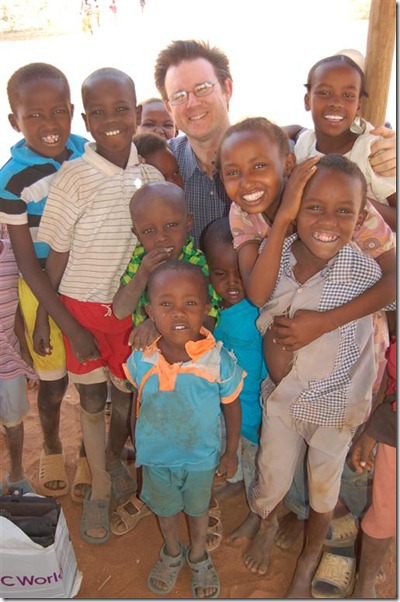
At Home
Nairobi City.
In Nairobi, I spent some time with my mother in my childhood home. I made the mistake of posting a status on Facebook saying I had “arrived home” which sounded like I’d gotten back to the US, except I meant I was in my old room in my old house. I spent a couple of days meeting old friends and realizing that they are just as excited at this potential ministry as I am. My best friend, Oscar, and his wife, Catherine, were of particular encouragement as Catherine works at World Vision and was able to set up meetings for me with some of the personnel there. The skyline of Nairobi shows a city of mixed age. The round building just left of center used to be the tallest building, but is now overtaken by many newer facilities. In the foreground in Uhuru Park, one of the Nairobi’s public parks. Below is the house I spent my last few years in before I came to America. My bedroom is the one behind the extreme right second story window.
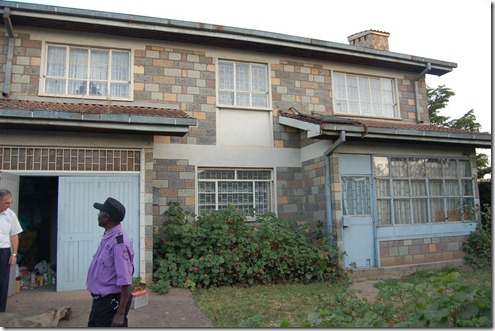
At home.
This is the first update of several which will include the development of a video presentation with the sights and sounds of Rendille included.
Yours in Christ, Jonathan.







































